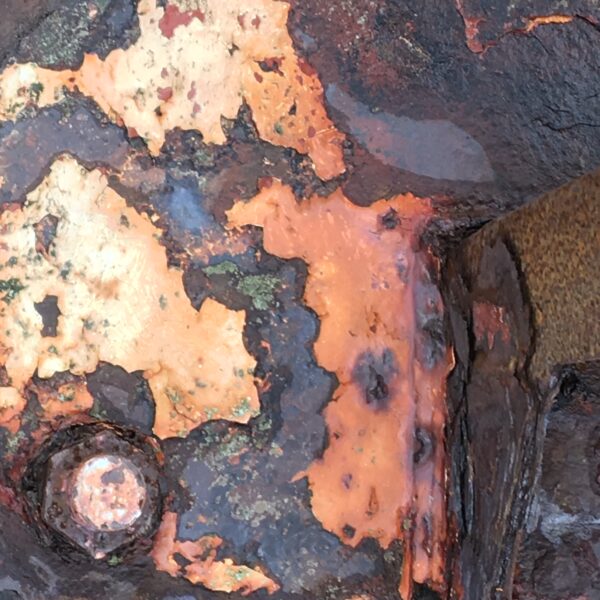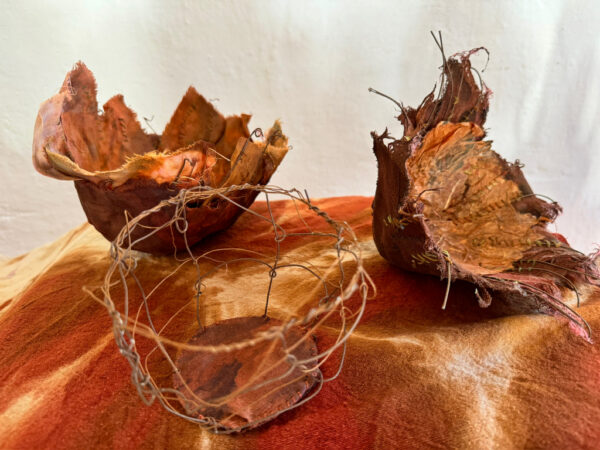


If you had spent these last few weeks at an art residency in far-off Buenos Aires or Finland, it might be time for a reassessment of your progress. Perhaps you might even be saying goodbye to new friends, having the last dinner or coffee at your favourite restaurant and figuring out how to get to the airport…
But it’s not quite like that at our Artists Deep Dive - we have taken longer to get set up and plan our focus and that time has been well spent, building the foundation that will take you far into the future. There is no right or wrong amount of time.
And now, it's worthwhile to pause and assess how you are feeling about your progress and results so far. Here are some reflections you might like to journal or sketch and consider:
- Right now, is my focus where I expected it to be?
- Has my focus matured or evolved from my intention?
- What has kept me from my practise? How can I change that?
Or you might find it helpful to summarize your progress and results….”so far I have completed…I am happy with…I need to research/study/write/draw about"....as well, share a summary in our Zoom Group, we all want to support each other in this community. In addition, I find the weekly accountability to be important as way of encouragment and support for each other.
Spend a few moments reviewing your letter of intention and your mind map - are there areas you've forgotten about or parts that now seem irrelevant? Or something that excites you more than before?
If you are close to finishing or have finished one piece - showcase it in your studio - set it up and admire it and show it off to others. Celebrate!
What about my Failures?
Sometimes a piece isn't quite what I want it to be.... and I see it as a failure. We're already discussed those that we don't want or need to finish - we've learned or mastered the techniques and can incorporate it into our future work. Or perhaps realize its not suiting the vision we have in our minds (or mind maps)...
But there's those pieces that I had exciting dreams for and I have a couple options:
I can try and hammer it into something better - do I clearly see ways to improve? Is it worth the effort? Or is my time better spent moving on?
Do I toss it into a corner and think I might change my feelings about it? Or perhaps cut it up into something else? A lot of my greeting cards are created that way!
Or does it go into the garbage and out of my life and mind?
Each of those failures might have a different answer. I know that one of them might get cut up into something smaller - I am undecided if the design is contrived or an idea worth letting mellow.
One other is a failure - someone in my family suggested I keep it but honestly, I don’t want it to reflect the quality of my art practise. So it will get tossed!
I think its vital that we embrace failure as part of the journey to creating something new. Accept that mistakes can happen and use them as an opportunity to learn and grow. I will probably write down my thoughts and consider that the failed piece is a successful art lesson!
You might enjoy these readings:
http://www.thirdtext.org/Failure-As-Art
Here's another thought - what is the difference between mistakes and failures: https://www.art2life.com/2023/08/16/the-art-of-mistakes-nicholas-wilton-ep-95/
Here's another podcast dedicated to failure ( I just found them and have put it on my playlist):
https://www.artoffailurepodcast.com
As an addendum, I found this article about staying true to oneself as an artist and the importance of following one's passion.
If I don't care about my work, how can I expect anyone else to? I'm not going to cry as the work heads to the garbage!
https://www.artworkarchive.com/blog/how-to-make-art-that-people-really-care-about
In a recent meeting with my art business group, we discussed how the best art is when we put ourselves and our voice into the work.
And here, one of us mentioned that a fear could be when the intention within us couldn't be brought out into the work - there was a breakdown in communication between vision and reality.
When you are standing in front of a masterful piece of art that moves you - the artist has put themselves into the art.



Keeping Motivated
Do you think it will be challenging to stay motivated after the Artists Deep Dive ends? We won't be meeting but your art practise is still waiting for you - if it has a voice, it might whisper or do you think it would be shouting at you?
During the Deep Dive, you have been building skills to help you stay focused and build good working habits in your studio. You have identified the path forward and have already started to take steps to get there. Moving forward, you may want to jot down your next steps, as this can provide a sense of motivation and accomplishment.
We are well used to giving ourselves rewards - "if I finish this, I will have that chocolate bar" but there is also a built in failure to this...if I don't finish then do I deserve the chocolate bar? Instead, what if we built "treats" into our daily routine? A latte at Starbucks, a bouquet of tulips for the dining table? When we have regular treats, it means that we are worthy of them, not that we have to earn them. There is a huge difference between these approaches and we need both of them at different times as they serve different purposes.
Here's Gretchen Rubin again: https://gretchenrubin.com/articles/what-are-your-treats-that-dont-look-like-treats/



Is Time is Irrelevant?
As I age it seems there is less and less time ahead of me to be creative and make my soul-fed art. I often feel rushed and pressured, hurry, hurry, hurry - work, work, work! I just googled “running out of time to make art” and found 7 Steps to Double Your Art Making Time and 9 Things You Should Give Up to be a Successful Artist. So .... do I need to hurry more and work harder?
I have given up some things to be an artist - housework beyond the most basic, gourmet cooking (DH has learned to read recipes) and some tasks that I think are unnecessary or unimportant. But there are other things which I will not give up on…travel, family and friendships. I would guess that you might agree with some of the above.
I am not Wonder Woman, sometimes I load my plate too full and that can be painful, both mentally and physically. Last night I was scratching a spot on my shin that flares up from time to time. My husband said - you're overloaded and doing too much - and yes, my body was telling me that! I need to take time for myself - I promise!
I understand that I won't be able to create all the art I desire in this lifetime. Perhaps my best work will stay within me. I can only do what is possible, and that will be sufficient. Nevertheless, I will keep making the best art I can – meaningful and soul-satisfying art!



Our Art(s) Communities
Can you count the number of different art groups you belong to? Maybe a local guild or society? Maybe a national or international association? I counted up the number I am a member of - for this purpose I only included those that I join with a membership fee:
Victoria Arts Council, Southern Gulf Islands Arts Council, CARFAC (Canadian), Cowichan Valley Arts Council, Surface Design Association, First Saturday, MISSA....and so on. Some of these require membership in order to exhibit or they support the arts in some way, they can be educational or involve advocacy.
Every Monday morning at 8:00am I meet with Suzanne and Chantal on Zoom for accountability, encouragement and learning best business practises - those meetings are important to me and I count them as friends, even though we've never met in person!
And then there's the more informal groups - the knitting group or sketch club, where friendship and community are more important. Those are the ones that nurture or comfort with warm hugs and hot cocoa.
All these groups are important to me as opportunities for learning and outreach through my art.
What are your communities? How do they help? Are they critique groups that will help your art develop and grow, perhaps challenge you to work outside your boundaries? Self analysis of our work can be incredibly useful - sometimes we know intuitively when and how a piece isn't working well or isn't that vision and we know how to change or fix the issues. Other times its helpful to be part of a group that will support us in growth through examining our art more closely.
You have probably heard of (or experienced) the very worst kind of critiques where the artists gave up and never went back to their practise, feeling that failing in art was failing in everything they held important. We never want to have that sort of experience. Perhaps you are already part of a group and know how to ask for, receive and offer critiques? We'll count on you next week for some input!
In the meantime, let's look at some ways to approach the topic of asking for feedback:
When you ask for help or suggestions, be specific. If you ask too broad a question you'll get silence or even worse: "I like it"! Here is an idea of where to start:
- What am I trying to achieve - "a landscape that evokes mystery"
- What is my subject or inspiration? What is the story behind it? "I was on a road trip and took the photo as the sun was rising".
- What I think is weak or needs help in my piece? "the colour choice seems too dark" or "the right side seems out of balance"
Then ask for answers to those questions:
- should I add more light?
- if I changed the proportions?
- would it work better, if I?
What comes next? Make note of the feedback you recieve - better yet, ask someone to write down the feedback for you - it frees you up to listen and concentrate, ask for clarification or further questions. Next step - thank those providing feedback and remember they are looking at the art, not you. Its hard not to take it personal - but they are there to help....
You won't always agree with the responses - in fact, it might be odd to agree with everything! After the critique, your next steps are your choice. Will you use the feedback to make changes - sometimes its difficult in a finished piece of textile art - a better approach might be to make notes on the changes you'll make for the next piece - or even play with changes in a photoediting programme and test out the ideas. But ehlping each other is a way for us all to grow as artists - both those receiving and providing the feedback.
Over the next few days, I'll be sending out ideas about the other side of this - how to provide constructive comments and we'll practise at our next Zoom meeting.
In the meantime here are some resources for you:
https://valeriewilsonartist.com/critiquing-art/
https://www.denapaints.com/blog/138943/avoid-the-horrors-of-the-casual-group-critique
https://snarkyquilter.wordpress.com/2016/09/30/another-perspective-on-art-quilts/
and here is one on developing skills for self - critique:
https://claranartey.com/self-critiquing-your-artwork/





